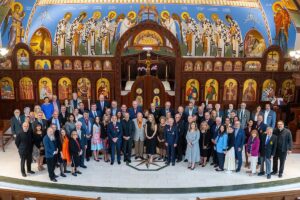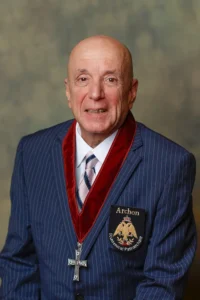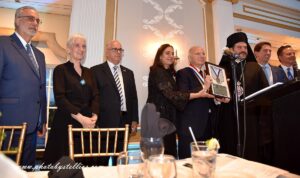“September 6, 1955: Krystallnacht in Constantinople”
By Speros Vryonis Jr.
Published in September/October 2007 issue of Greek America Magazine
|
Most Greek Americans and most Americans generally are unaware of the fact that on the evening of September 6, and in the early hours of September 7, 1955, the Turkish government carried out the most destructive pogrom that had been enacted in Europe since the infamous Krystallnacht which Hitler and the Nazis inflicted upon the Jewish communities, businesses and synagogues on the eve of World War II.
Further, most are unaware that the Turkish government had unleashed the mobs on the Greek community of Istanbul, on its churches, houses, businesses, schools, and newspapers; and they are unaware that this resulted in the ultimate destruction of Turkey’s oldest historical community, about 100,000 Greek Orthodox Christians who were the heirs of Byzantium.
On September 6-7 of 1995-2005, the Greek press in Greece, and the Greek American, the Greek Canadian and the Greek Australian presses memorialized this great tragedy so that more than forty years after the events, Greeks, and humanity more generally, might not forget the victims and might recall that the forces restraining barbarians are to be kept at the ready at all times.
This is an example wherein the press serves as mankind’s historical and ethical teacher. I should add that many Greeks and Greek Americans have lost their sense of history, of whence they came, of who they are, and of what they are becoming.
Is it possible today in America, where we constitute an affluent, politically powerful, and highly educated Hellenic diaspora, that we know so little about something so simple and yet so fatefully significant about the Turkish pogroms that destroyed this ancient Greek community in Constantinople in 1955?
That we are unaware that on September 6,1955, the Turkish mobs and government organized and carried out the worst and most destructive pogrom in Europe since Hitler and the Nazis destroyed the synagogues and businesses of the Jewish community in Germany?
The chronology of the pogrom falls in a very difficult period, when the Cyprus problem had complicated the political relations of Greece, Turkey and England.
The Turkish press, which was to play a crucial role in preparing the political atmosphere of the pogrom, received significant financial support from British sources. Specifically, the British gave financial assistance to two Turkish newspapers and to their owners/editors: to Hikmet Bil (editor of the newspaper Hurriyet and leader of the political organization Kibris Turktur – Cyprus is Turkish), and Ahmet Emin Yalmas, owner of the older Istanbul paper Vatan.
In 1952, the Turkish government had mobilized two large student organizations. By July 1955, the Turkish press and these organizations activated intense pogroms and demonstrations aimed at the defenseless Greek minority in Istanbul.
The tripartite discussions, among Greece, Turkey and England, commenced in London in August of 1955. On the 27th of that month, the Turkish press condemned the Patriarch, ostensibly for collecting funds for the Greek Cypriot movement for Enosis with Greece. Three days later, on August 30, the anniversary of the day when the Kemalist forces smashed the Greek line in western Asia Minor, the Turkish press launched a particularly vile attack on the Patriarch. Previously, on the 27th, the Istanbul newspapers published false rumors that the Greeks of Cyprus were planning mass genocide of the Turkish Cypriots.
Finally, on September 5, one day prior to the pogrom, Turkish student organizations asked permission from the authorities to stage political demonstrations in Istanbul regarding Cyprus, to be staged on September 13.
Also on September 5, the Turkish prime minister’s executive council, which included the minister of the interior in charge of security, the governor of Istanbul, and the chief of police, among others, met to discuss the petition and the situation more generally.
|
It should be noted that prior to the tripartite meetings in London, it is generally accepted that the British government asked that the Turks stage a public demonstration on Cyprus, inasmuch as this would strengthen the Anglo-Turkish position against that of the Greeks during the tripartite meetings.
On the 6th of September, the Turkish press and other media announced the explosion of a bomb in the Turkish consular complex in Thessaloniki, within which is located the ancestral house of Mustafa Kemal Ataturk.
This news was announced quickly and simultaneously throughout Turkey, and the prearranged plan of the pogrom was applied and put into action, rhythmically, by its organizers, who were in effect the Turkish state.
As the examination by the Greek police of Thessaloniki demonstrated soon after the explosion, the bomb was not thrown into the compound from outside the walled compound, but was placed on the grounds by an individual from inside the compound; a conclusion arrived at after a police examination of the actual form of the explosion, evidenced by the directions of the damage. This conclusion is confirmed by other independent evidence.
The damage inflicted by the bomb on buildings inside the walled compound of the Turkish consulate was purportedly revealed in the photographic evidence published by the Istanbul Express, which went to press in Istanbul on the same afternoon of the day of the explosion.
How was it possible to bring the photographs from Thessaloniki to Istanbul, develop them and publish them on the same afternoon, in a day and age when there were no airplane flights between Thessaloniki and Istanbul, and at a time when the bus would not have arrived in Istanbul until well into the night? The answer comes from the report of the investigation by the Thessaloniki police who reported the following incontrovertible facts:
First, the Turkish consul had left his post for Istanbul long before the event in question, leaving behind his wife to take care of “last minute details” before departing herself to join her husband.
Among these “last minute details,” she was to telephone a photographic studio in Thessaloniki to hire a Greek photographer to photograph the inside of the walled complex of the Turkish consulate. A few days before the explosion of the bomb, she departed with the photographs for Istanbul.
It was this photographic material which appeared in the afternoon edition of the Istanbul Express on September 6. Thus, there had been ample time to bring the photographic films to Istanbul and have them developed before the bomb exploded.
However, the original photographs had been tampered with and had been altered to show purported damage to the house of Ataturk – all this before the actual explosion of the bomb.
Thus, the Thessaloniki police could compare the photographic “evidence” published in the afternoon edition of the Istanbul Express on September 6 and identify it with the photos produced by the Greek photographer, and to show, on the basis of their investigation, that the Turkish version of the explosion had been falsified.
Thus, the Turkish forgery had been both detected and reported. It was recorded in a British consular report to the British Foreign Office. The Foreign Office official who received the report in London wrote on the margin of the report, “The Greeks will go to ridiculous extremes to deny their responsibility in the placing of the bomb in the Turkish consulate of Thessaloniki.”
The Greek police charged a Turkish student, a Greek citizen with having placed the bomb, with the willing complicity of the Turkish doorman of the consulate. His name was Oktay Engin.
When Demirel was, in recent years, reelected to power, he appointed Octay Engin as chief in charge of the affairs of the Turkish community in Greek Thrace, 37 years after the fact of the bomb.
The guilt of the Turkish government and of its consular official in Thessaloniki in placing the bomb on the grounds of the consulate was further confirmed by the Turkish court martial of Yassiada in 1960-61, which condemned Prime Minister Adnan Menderes and his Foreign Minister Zorlu for the organization and execution of the Pogrom of September 1955 and for the bomb exploded in the consular compound.
|
Let us now glimpse briefly at the pogrom itself, ostensibly set off by the announcement of the bomb explosion at the Turkish consulate in Thessaloniki, but which in fact had been carefully planned by the Turkish government.
At this point, I quote specific paragraphs from an official Greek document with the title: “A Note of Summation of the Consul General of Constantinople, Vyron Theodoropoulos, on the anti-Greek Events of September 6, 1955.”
This official report was written by a diplomat who had served as consul general during the events in question, and who was appointed by the Greek Foreign Office to make an investigation and report to the ministry The document impresses with its wealth of information as well as by the objectivity of the analytical nature of its perceptions.
In this official report we read the following, terse catalogue of the events during the destructive night of the pogrom.
“The execution of the plan [for the pogrom] reveals two basic characteristics: (1) A well-effected and harmonized time schedule of actions, and (2) effective coordination. “The time schedule of events unfolds, generally, as follows:
“1:30 p.m., announcement on the radio of the bomb in the house of Ataturk in Thessaloniki.
“4:00 p.m., a special supplement of the newspaper Istanbul Express circulates, publishing this ‘news’ and featuring an artificially altered photograph of the purported destruction of the house [of Ataturk].
“4:30 p.m., groups of young people roam about the main streets of Pera, writing on the walls insulting slogans against the Greeks.
“5:30 p.m., the first groups of demonstrators gather in Taxim Square.
“6:00 p.m., the gathering in Taxim Square listens to various speakers who are making inflammatory speeches against the Greeks and Greece.
“6:30 p.m., the assembly is transformed into a demonstration, in which one group reaches the General Consulate of Greece but is dispersed by the immediate appearance of police forces, who close off all access to the consulate.
|
“7:00 p.m., there commences the smashing of display windows and iron doors of the Greek shops on Taxim Square and of the shops on Pera Street. Almost simultaneously, acts of violence begin to be manifested in the remaining neighborhoods and suburbs, so that, within two hours, the attack on and destruction of Greek property has become general and widespread through the enormous territorial triangle formed by the east tip of the Bosphoros-Sariyar and Yeni Mahalle – as far as the Propontis- St. Stephan and the Isles.
“2:00 a.m., September 7, or just a little thereafter, martial law is declared and the first military contingents make their appearance. After this, the situation becomes quiet.”
“The timing and coordination of the demonstration (riots) acquire even greater significance inasmuch as they were combined with a strategy of burning and destruction.
One can distinguish, more or less, three waves of attackers:
“1. The first wave has as its goal to break down the doors and display windows (prosthekes) of the stores and the iron doors of the (Greek) houses, thus to prepare the way for the actions of the second wave.
“2. The second wave was to pillage and carry off all that was capable of transport.
“3. The third wave had as its task the complete destruction of (all property) that remained.
“However, the organizers of the events had accomplished other noteworthy deeds, for instance:
“a) In the center of the city, with very few exceptions, private houses were not looted. Looting of the houses was limited to the neighborhoods and the suburbs.
“b) Blood was not shed, not because the rioters were unable or did not want to shed it, but because they were not permitted to proceed to violence against the people.” (In effect, recent studies showed that some 28 Greeks were murdered, and original reports reveal extensive rape of women – Speros Vryonis, Jr.)
“c) The attack groups were fully equipped with the necessary instruments: crow bars, sledge hammers, iron rods, even with acetylene blow torches for breaking safes open.
“d) The equipping of the attackers with these tools obviously took place following a prearranged plan via trucks stationed in convenient sites throughout the city…
It is reported that vehicles belonging to the municipality (of Istanbul) were also seen carrying out these functions.”
|
From these observations, the experienced Greek diplomat drew the following conclusions in his report:
“That which is certain, and which is addressed in the following chapter (of the report), is that there was a long period of methodic preparation so as to achieve such a perfect organization of the riots. Characteristic of this fact are the very statements and confessions of the Prime Minister Adnan Menderes to the Patriarchal committee, which visited him after the riots, to the effect that these riots had been started and planned over a five-year period.”
It is significant to examine the time schedule of the events attendant upon the pogrom so as to see how, actually, the Hellenism of Constantinople was physically destroyed between 7:00 p.m., September 6, when the Turkish mobs began to smash the doors and windows of thousands of shops and houses, churches, schools, Greek newspaper establishments and then to loot the goods and possessions of the Greeks, and, finally, to destroy the physical establishments themselves, often with fire, until 2:00 a.m., September 7, when the Turkish authorities established martial law in the city.
In other words, this historic Greek community which had lived and created in the city on the Bosphoros from its first foundation in 668 B.C. up to 1955, for some 2,623 years (some 104 generations), suffered a complete and destructive catastrophe in only seven hours.
No one moved even so much as one finger to save this most historic Greek diasporic community, neither Greek nor Christian, nor so-called civilized man or woman, and certainly not the Turkish government or the Turkish nation.
Let us now leave this Greek consular report on the pogrom lest it be thought that I am relying on a Greek document which was written under the emotional trauma and upset of these horrible events.
I shall cite to you from yet one more official document. This is the official report and description of the pogrom which the American Consulate in Istanbul forwarded to the American Secretary of State, Mr. John Foster Dulles, and the U.S. State Department on September 27, just three weeks after the violent destructions of the pogrom, and which was kept secret through austere classification and reserved only for official use. This document was declassified many years later, but only for a brief period, since it has evidently been reclassified recently.
A survey of the damage inflicted on public establishments of the Greek Community of Istanbul during the rioting on the night of September 6-7 shows that the destruction caused has been extremely widespread. In fact, only a very small percentage of community property appears to have escaped molestation. Although there are as yet no figures available assessing the damage sustained, the number of establishments attacked and the nature of the destruction caused in the course of the night under reference convey a clear picture of the scope of the devastation.
In most cases the assault on these establishments involved a throrough wrecking of installations furniture, equipment, desecration of holy shrines and relics, and looting. In certain instances serious damage was inflicted on the buildings themselves by fire.
Reports show that the dependencies of the religious edifices hit were also not spared and that very serious damage was inflicted on presbyteries and well-appointed community meeting quarters, libraries, and dispensaries attached to these establishments.
Among the Greek churches heavily attacked also figures the church of the Greek Catholic Uniate at Hamal Bapi, Beyoglu. Report has it that the presbytery of the said church and the congretional school attached thereto were also severely damaged.
As a matter of fact three other Catholic churches having no other connection whatever with the Greek community, are reported to have also suffered serious damage during the rioting.
Reports on hand indicate that the rioting crowd hit with particular frenzy at two important Greek Orthodox community centers: the central cemetery at Sisli and the cemetery of the Patriarchs at Balikli. The former sustained particularly extensive destruction. Crosses and statues were knocked down, sepulchers and vaults opened and remains of the dead removed and dispersed. At Balikli, the sarcophagues of the Greek Orthodox Patriarchs were desecrated.
As for the Greek Orthdoox clergy itself, considering the scale and severity of the acts of violence recorded, it appears that only a relatively few were exposed to the fury of rioters. According to information given by the Patriarchate only one aged Orthodox priest, monk Chrysanthos of Balikli, is believed to have been killed during the rioting. Since his body has not been recovered, he is listed as missing. It is supposed that he perished during the burning of his church.
|
Extensive damage also seems to have been suffered by the educational establishments of the Greek community. At least 36 of the 48 schools of the community are reported to have been more or less seriously damaged. The principal victims are the Zappeion Girls’ College at Taksim and the Megali Scholi Boys’ College of Phanar, both princes of the community, the Theological School at Heybeli, and the high schools at Haskoy, Edirne Kapu, Bakirkoy, Gelata, Taksim and Arnavutkoy.
The elaborate dispensary of the Takrim High School and several public soup kitchens operated in conjunction with these educational institutions were also demolished.
Efforts are now being made to immediately repair some of the damage to make possible opening of these schools by the end of this month. To that effect a preliminary aid of 110,000 Turkish liras has been allocated to the Community by the Turkish authorities. Special appropriations are also expected for the repair of damaged religious institutions and cemeteries since, neither the community itself nor the Patriarchate is in a position to provide adequate funds for the purpose. As the allocation of such funds will require legislative action, an emergency relief of 200,000 Turkish liras is announced for urgent repair work.
Though not specifically community property, it might be appropriate to consider in the present report also the damage sustained by the Greek language press of Istanbul. All three principal dailies, the Apoyevmatini, the Tachydromos, and the Embros suffered heavy losses. The first two had both their offices and printing establishments completely wrecked. In the case of the Embros only its offices were destroyed since it had no printing press of its own. The Apoyevmatini (circulation 10,000), the most heavily hit, managed to resume publication two weeks after the rioting. Its losses alone are estimated at half a million lirae. The Tachydromos (circulation 5,000) has as yet not been able to recuperate from the blow but is scheduled to appear in the near future. The Embros (circulation 7,000) reappeared a few days after the disturbances. The weekly Okroids (circulation 5,000) managed to continue publication without interruption though its offices were also heavily wrecked. Like the Embros it has no printing press of its own.
As pointed out in the opening paragraphs of this report a monetary assessment of the damage caused to Greek Community property in the course of the September 6 riot has as yet not been attempted. Very general estimates on the part of community and church leaders would indicate that it goes into millions of Turkish liras. The Department will be informed as soon as a substantive estimate is available.
|
The lethal pogrom of September 6-7, 1955 delivered a fatal blow to the Hellenism of Constantinople in seven hours. Well planned (for some years), masterfully carried out in a well organized manner by the Turkish government, the Turks destroyed 71 churches, 41 schools, 4,008 stores, the offices and printing presses of eight newspapers, and approximately 2,100 dwellings, all the property of the Greeks and their communities.
The Turks killed 28 Greeks and also carried out the rapes of Greek women. They profained and soiled the Greek Orthodox religious vessels; they smashed and dug up the graves in Greek cemeteries, throwing out the bones and remains of the dead; they effected circumcisions on some elderly priests on the streets.
The Turkish government, press, and nation “justified” this savagery on the false pretext that the Greeks had bombed the house of Ataturk in Thessaloniki. In reality the Greeks had not placed the bomb in the Turkish consular complex in that city on September 6. It had been put there by a Turk, in collusion with the Turkish government, in order to provide the pretext for a carefully laid plan to destroy the houses, the businesses, the property, the churches, the schools, the newspapers of the Greeks in Constantinople.
It was a “logical” sequence (in Turkish minds) to the oppressive Valik Vergisi of 1942-1943, a Turkish confiscatory law which destroyed the economic bases of the Greek, Turkish and other minority communities. The pogrom of 1955 was a Turkish “success” as it finally destroyed the ancient Hellenism of Constantinople, both in physical and psychological dimensions.
(Editors note: All photos provided courtesy of Greekworks.com, publishers of Speros Vryonis Jr.’s important book “The Mechanism of Catastrophe.” Special thanks to Stelios Vasilakis for his assistance.)
The shame of Sept. 6-7 is always with us
Wednesday, September 7, 2005
Reprinted from the Turkish Daily News
I am one of the living witnesses of what happened in Istanbul 50 years ago. I was 14 years old. I did not know what it was all about. However, the passage of time made me understand the seriousness of the incidents and I always carry the shame.
Even though it was the only such incident in which the Turkish state officially admitted its culpability and tried to compensate its victims, it still continues to weigh on our conscience.
I can never forget. I can still remember what I saw in Beyoglu on the morning of Sept. 7, 1955.
I had to go to Galatasaray High School to register for their preliminary class. I reached Beyoglu with great difficulty. When I went to Tunel from Karakoy, I just was flabbergasted.
The scene was shocking. The huge street seemed like a war zone, with windows of the shops on both sides of the street shattered and all their goods strewn all over the street.
Bunches of clothes, books, notebooks, chandeliers and much more. People were taking home whatever they could find. The scene was like judgment day.
I was a child, and I had no idea what had happened.What I noticed immediately was that while some shops were plundered, others were not even touched. I had a look and saw that there was a Turkish flag hanging on the windows of the shops that were not looted. Those that were had Greek names.
People with long beards and those who were dressed very shabbily were walking around. I saw that some people who were dressed normally were hiding in the shops, looking outside.
The police and the soldiers seemed like they were saying: Enough is enough. You did what you did, but now just leave. They were both intervening and not intervening at the same time.
That scene has always remained with me.
Even though half a century has passed, I still shiver when I remember it. When I read the newspapers a day later, I realized the extent of the matter.
Similar incidents had occurred also in Taksim and Sisli, where most of the citizens of Greek origin lived. Not only the shops, but also churches, even cemeteries were damaged and plundered. Jewish citizens also got their share of trouble, but the main targets were Greeks.
Newspapers were writing about people waving Turkish flags, pleading with the looters: Please don’t do it. I’m a Turk. I am a Turkish citizen.
It was a disgusting, belittling and tragic affair.
My mother and other adults were criticizing what had happened, while officials were talking about the placing of a bomb at the house in Thessaloniki where Ataturk was born, which had been turned into a museum, and the anger felt against what was happening in Cyprus, explaining that the people had become enraged.
We were living on Ethem Efendi Street at the time. Our neighbors were mostly Greek. They were my best friends. All of a sudden, they shut themselves in their homes. They talked to no one. I can never forget Madam Eleni when she asked, Can we seek refuge in your home if they attack us? The barbershop she managed with her husband was in ruins. They were in shock. My mother sent them food for a week. We let them live in one of our rooms.
I was too young to make sense of what had happened. Why should they attack Madam Eleni? What could they ask from them? Why were they different from me?
As I was seeking answers to these questions, the Greek families in our neighborhood started to move to other places or go to Greece. After 1963 none of them were left. They left Istanbul.
They took with them an important culture, a color and a different lifestyle. They left us alone in Istanbul to live our colorless lives. Later on we were full of regret, but by then it was too late.
Turkey admitted all culpability, accepted responsibility. Much later, we learned the Sept. 6-7 incidents were the doing of the infamous deep state. It was planned with government approval in order to let diplomats say The people are reacting during the U.N. discussions on Cyprus. However, it later got out of control and turned into a shameful plunder. It became a crime that the deep state could not handle, and it shamed the Turkish nation.
What’s interesting is that apart from a few injuries, no one was killed. It wasn’t a massacre. It was a disgusting plunder aimed at frightening people.
What’s even more interesting is the way Sept. 6-7 shamed us and hurt us and tainted us as a nation.
This was also recorded as the only such incident when the Republic of Turkey officially admitted its responsibility, apologized and compensated the victims.
At the Yassiada trials, after the May 21, 1960 military coup, the Sept. 6-7 incidents were investigated down to the smallest detail, and those held responsible were tried and punished.
As always, there was no mention as the deep state. It emerged entirely unscathed by the affair. A few thieves, civilians with no links to the planning or to the politicians, were punished.
In the later years, whenever the Sept. 6-7 incidents were mentioned, I felt an overwhelming shame and I always apologized to the victims I saw at international meetings.
During the Sept. 6-7 incidents our Turkishness was trampled underfoot. It was then I realized that if we don’t criticize such incidents and apologize to the victims, we can never feel proud of ourselves.
Apologizing is enriching. It shows self-confidence.
Discriminating due to religion, language or culture or using force on the weak is belittling one’s self.
I don’t know you, but I apologize to our neighbor Madam Eleni from Erenkoy.
Mehmet Ali Birand














